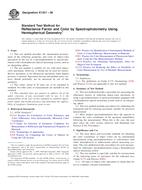Potrebujeme váš súhlas na využitie jednotlivých dát, aby sa vám okrem iného mohli ukazovať informácie týkajúce sa vašich záujmov. Súhlas udelíte kliknutím na tlačidlo „OK“.
ASTM E1331-09
Standard Test Method for Reflectance Factor and Color by Spectrophotometry Using Hemispherical Geometry
Automaticky preložený názov:
Štandardná skúšobná metóda pre faktor odrazivosti a farbu spektrofotometria s pologuľovitý geometrie
NORMA vydaná dňa 1.12.2009
Informácie o norme:
Označenie normy: ASTM E1331-09
Poznámka: NEPLATNÁ
Dátum vydania normy: 1.12.2009
Kód tovaru: NS-41329
Počet strán: 4
Približná hmotnosť: 12 g (0.03 libier)
Krajina: Americká technická norma
Kategória: Technické normy ASTM
Anotácia textu normy ASTM E1331-09 :
Keywords:
color, hemispherical geometry, reflectance, reflectance factor, spectrophotometry, Color--opaque materials, Colorimetric analysis, Geometric analysis--paints/related coatings/materials, Hemispherical geometry, Instrumental measurement--color/light, Reflectance and reflectivity--paints/related coatings/materials, Spectrophotometry, ICS Number Code 17.180.20 (Colours and measurement of light)
Doplňujúce informácie
| Significance and Use | ||||||||||||||||
|
The most direct and accessible methods for obtaining the color coordinates of object colors are by instrumental measurement using spectrophotometers or colorimeters with either hemispherical or bidirectional optical measuring systems. This test method provides procedures for such measurement by reflectance spectrophotometry using a hemispherical optical measuring system. This test method is especially suitable for measurement of the following types of specimens for the indicated uses (Guide E179 and Practice E805): All types of object-color specimens to obtain data for use in computer colorant formulation. Object-color specimens for color assessment. For the measurement of plane-surface high-gloss specimens, the specular component should generally be excluded during the measurement. For the measurement of plane-surface intermediate-gloss specimens and of textured-surface specimens, including textiles, where the first-surface reflection component may be distributed over a wide range of angles, measurement may be made with the specular component included, but the resulting color coordinates may not correlate best with visual judgments of the color. The use of bidirectional geometry, such as 45/0 or 0/45, may lead to better correlations. For the measurement of plane-surface, low-gloss (matte) specimens, the specular component may either be excluded or included, as no significant difference in the results should be apparent. Specimens with bare metal surfaces for color assessment. For this application, the specular component should generally be included during the measurement. This test method is not recommended for measurement of the following types of specimens, for which the use of bidirectional measurement geometry (0/45 or 45/0) is preferable (Guide E179): Object-color specimens of intermediate gloss, Retroreflective specimens, and Fluorescent specimens (Practice E991). When there is doubt as to whether the specular component of reflection should be included or excluded, both measurements should be made, and the results correlated with visual judgments. Thereafter, the method with higher visual correlation should be utilized. When measurements of two specimens whose gloss, or texture, are substantially different from each other, are to be utilized in a color-difference comparison, generally the specular component should be included in each measurement. This has the effect of including in both measurements all the first surface reflections whether diffuse or specular. These first surface reflections are subtracted from each other in the color-difference equation, and differences in the body color remain, which is what is usually sought. |
||||||||||||||||
| 1. Scope | ||||||||||||||||
|
1.1 This test method describes the instrumental measurement of the reflection properties and color of object-color specimens by the use of a spectrophotometer or spectrocolorimeter with a hemispherical optical measuring system, such as an integrating sphere. 1.2 The test method is suitable for use with most object-color specimens. However, it should not be used for retroreflective specimens or for fluorescent specimens when highest accuracy is desired. Specimens having intermediate-gloss surfaces should preferably not be measured by use of this geometry. 1.3 The values stated in SI units are to be regarded as standard. No other units of measurement are included in this standard. 1.4 This standard does not purport to address all of the safety concerns, if any, associated with its use. It is the responsibility of the user of this standard to establish appropriate safety and health practices and determine the applicability of regulatory limitations prior to use. |
||||||||||||||||
| 2. Referenced Documents | ||||||||||||||||
|




 Cookies
Cookies
